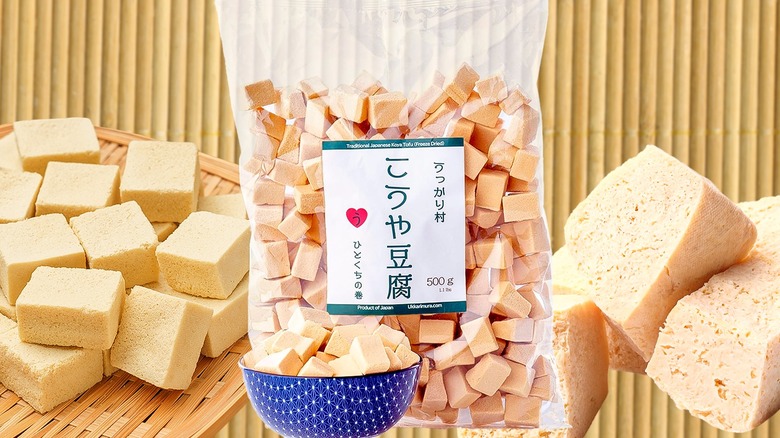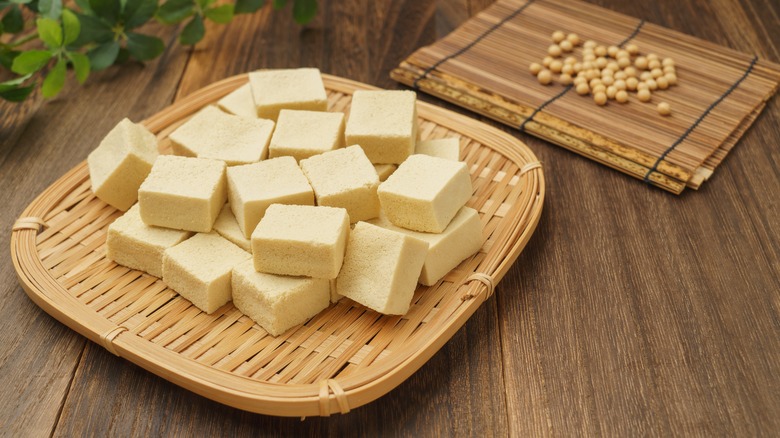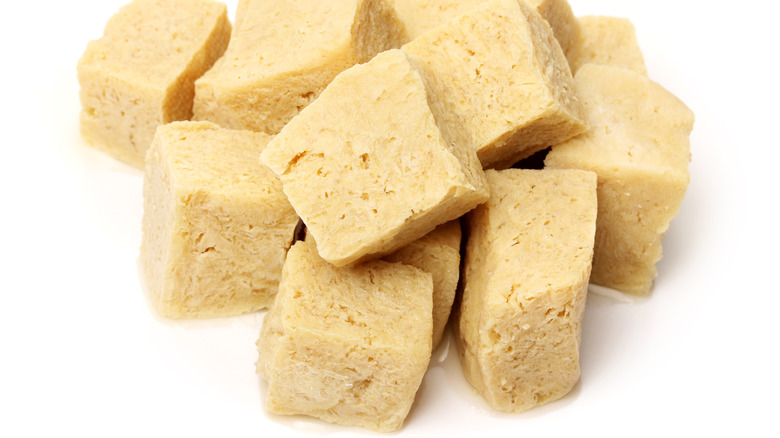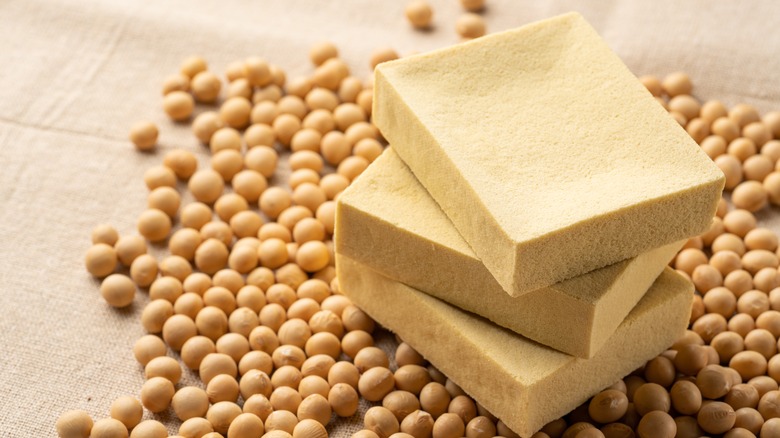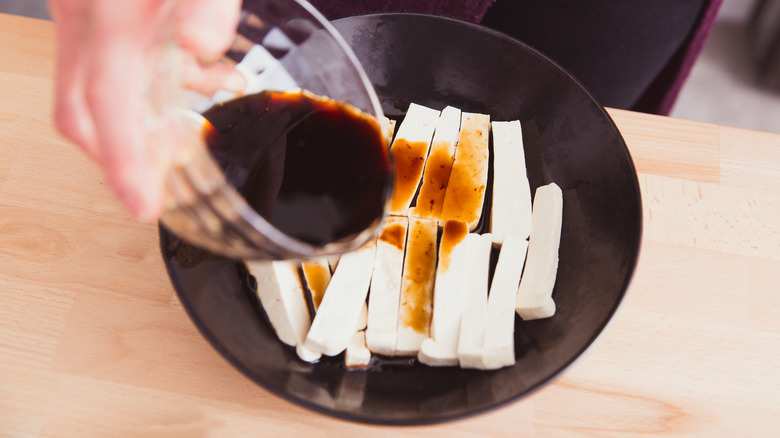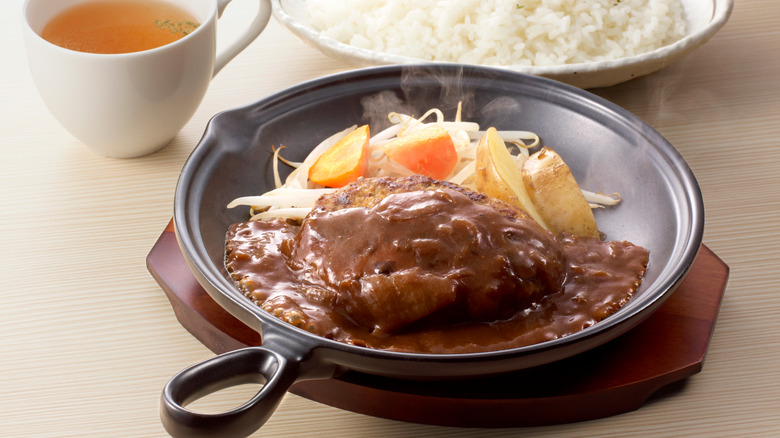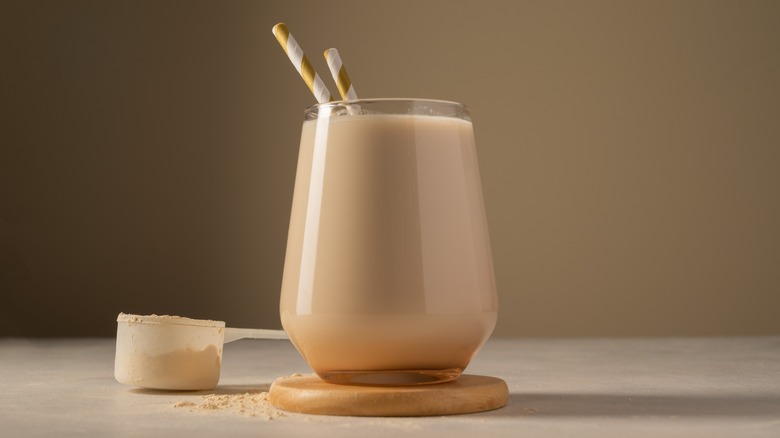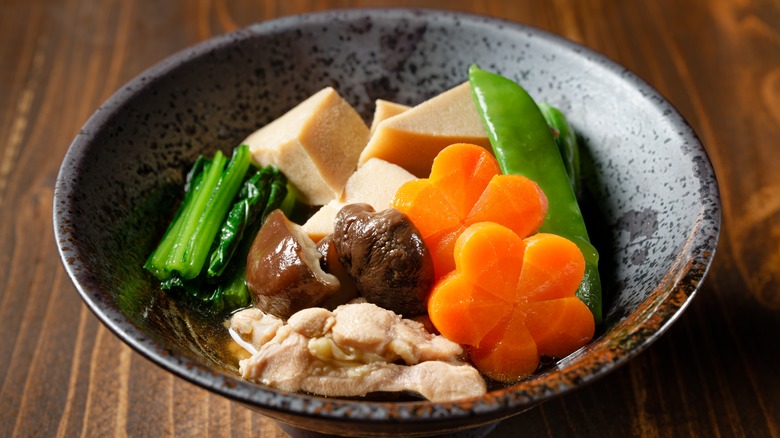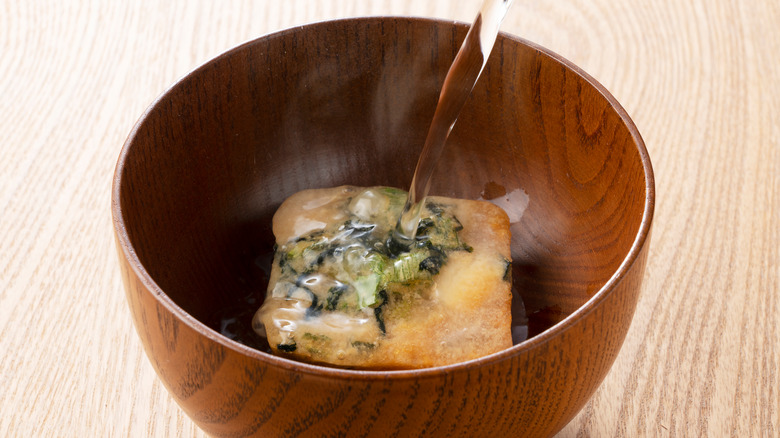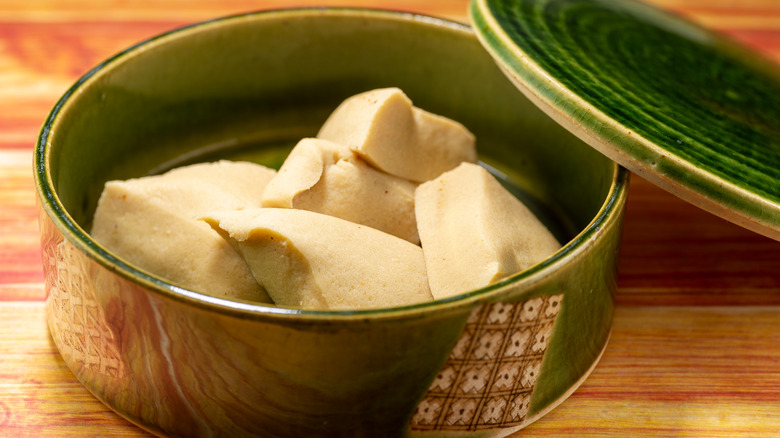What Is Freeze-Dried Tofu And How Do You Use It?
Freeze-dried tofu might be holy. It was first summoned into existence in Japan at the sacred esoteric Buddhist monastery Koya-san. Legend has it that a young monk accidentally left tofu outside one winter evening, and when he found it the next day, it was frozen. Whether it was a monk's mistake that led to frozen tofu in Japan or people just caught wind of the tofu-freezing methods China had already been developing, freeze-dried tofu was to be the next evolution.
Healthy, portable, and easily rehydrated to add a spongey, protein-rich flair to everything from soups and stir fries to curries and desserts. Frozen tofu may have been great for extending the storage life of tofu through Chinese and Japanese winters but the brick-like slabs were heavy and difficult to transport so Japanese monks and priests began experimenting with drying out the tofu, and the freeze-dried tofu that followed proved even better than its frozen counterpart. Both nutritious and lightweight, it was the perfect sustenance for traveling monks who subsequently packed their pockets full and began walking it to every corner of Japan.
What is freeze-dried tofu?
Freeze-dried tofu, as the name suggests, is tofu — which is made from coagulated, pressed soy milk curds — subjected to multiple cycles of freezing, thawing, and drying. Unlike other forms of tofu, however, which are renowned for being soft, wet, or spongey, freeze-dried tofu tends to take the form of hard, brittle blocks you can snap, which can be reduced to dry powder. This diversity is yet another reason why we'll always have a tofu-shaped space in our hearts (here are 22 other recipes that'll make you fall in love with tofu too).
Freeze-dried tofu is made from firm or extra-firm tofu — it can't be made from silken tofu because silken tofu is too fragile to be pressed, which is why it's so great for tofu scramble. From a nutrient-dense snack or dessert to the feature of a meal, freeze-dried tofu practically knows no culinary bounds.
How is freeze-dried tofu made?
Tofu is about 80% water, so freezing and then allowing it to thaw extracts the water entirely, leaving a sponge-like network of protein and other solids. Texturally, it becomes sponge-like and highly absorbent soaking, even more so than fresh tofu.
On Mount Koya, ½-inch-thick slabs of tofu would be rung out between bamboo mats and, later, left in the snow overnight and through the next day, out of reach of any sunlight. After 8 hours of exposure, the tofu slabs had turned into hefty frozen bricks, which were then placed on purpose-built shelves and left to the winter elements for one to three weeks before being thawed in warm water. The tofu was then dried via a charcoal brazier until light brown and crispy. Almost eight hundred years after the monastic Koya-Tofu or Koya-Dofu freeze-dried tofu, during the Momoyama period (1573-1603), another form of freeze-dried tofu appeared. This form, known as Shimi-Tofu was created by hanging a straw necklace-like string of tofu outside in the elements where it would freeze in the winter and dry out in the sunlight.
In contemporary Japan, there's an umbrella term that encompasses both types of freeze-dried tofu — Kori-Tofu — and, for the Nagano Prefecture, it's something of a specialty. Unsurprisingly, however, the traditional preparation method, which was far too tightly intertwined with the seasons to lend itself to commercial-scale manufacture, has mostly given way to manufacture by artificial freezing, tunnel dryers, calcium chloride, and ammonia.
How to make freeze-dried tofu at home
The texture of freeze-dried tofu depends on the size of the ice crystals and air pockets that form inside the tofu as it freezes. The lower the water content of your tofu, the finer the ice crystals that will form and the smoother the resulting texture. Therefore, the first step for making freeze-dried tofu yourself is squeezing as much water as possible out of your tofu. Hack your tofu-pressing by sandwiching tofu slices between paper towel-lined plates. Pile cans or other heavy objects on the top plate and leave overnight in the fridge or on the kitchen counter for about an hour.
Next, arrange ½ inch slabs of tofu on a tray and leave in the freezer for 48 hours or until the tofu has taken on a darker color, then bake at 170 for 2 hours or until crisp and dry. Alternatively, use liquid nitrogen or food-grade dry ice to freeze your tofu faster and a dehydrator to dry it out.
Where to buy freeze-dried tofu
Silken, firm, extra-firm, and soy puffs varieties of tofu have been a staple in mainstream grocery stores for some time now; if making your own freeze-dried tofu isn't for you, you'll need to look further afield, but only slightly — fortunately, it's relatively easy to source. While popular in Japan, freeze-dried tofu has yet to experience its moment in the international spotlight. You should be able to find it at your local specialty Japanese food store, or you can order it online from stores like Weee! or Eden Foods.
Freeze-dried tofu from Eden Foods is non-GMO and is made by freezing and air-drying it naturally, and it's free from additives and preservatives. Weee! stocks a woman-led brand called Yamashiroya; their tofu is also non-GMO. It's worth noting that this form of tofu won't necessarily be sold as 'freeze-dried tofu.' Instead, it might appear as 'dried tofu,' 'koya dofu,' or 'freeze-dried tofu.'
How to rehydrate freeze-dried tofu
In most cases, before you can cook with freeze-dried tofu, you need to rehydrate it, and the best rehydration method depends on whether you're using homemade or commercially made tofu, which usually contains ammonia and calcium chloride and is a slightly different beast.
For homemade freeze-dried tofu, place in a bowl and cover with boiling water for 5 to 10 minutes or until thawed. Swap out the hot water (or stock for an extra flavor boost) for lukewarm or cold water, then press between your hands to ring off the excess water. For commercial freeze-dried tofu, the process differs in that you'll place tofu and water or stock in a pan and cover it with a lid, leaving it for 3 to 5 minutes to allow it to swell. The ammonia content will likely make the water look milky. You'll then do the same hot-to-cold water swap, press, and then repeat for three more rounds of water and press.
How to cook with freeze-dried tofu
Regular tofu is known for its sponge-like qualities but frozen tofu and, therefore, freeze-dried tofu takes this absorption to the next level which means it's fantastic in high liquid dishes like soups, stews, and Japanese hot pot, or any recipe that calls for frozen tofu. Simmering freeze-dried tofu in dashi, soy sauce, and mirin is a simple, tasty braised meal known as Ichiya-Dofu which translates as Night-Dried. Change up the texture of any dish that normally features firm, extra-firm or fried bean curd/soy puffs by substituting for the freeze-dried variety.
Like regular tofu, it makes for a solid vegan meat option and can be easily subbed into any recipe that calls for meat. Alternatively, you can incorporate freeze-dried tofu in less expected ways like tofu french fries where you lightly flour then deep fry tofu slices for a protein-rich side, or plant protein-spiked base for poutine.
How to use freeze-dried tofu powder
Instead of rehydrating your freeze-dried tofu straight away, you can pulverise, grate or blitz in a food processor to turn it into instant tofu powder. There isn't a lot of buzz about this powder online and it's near impossible to buy pre-made so it's easiest to make it yourself. It's different from okara which is a soy pulp byproduct from soy milk and tofu production. The powder makes for a great protein-rich gluten-free alternative to breadcrumbs, or as a binder in Japanese hamburger steaks (or any hamburger patties, for that matter).
A more unusual use for instant tofu powder is combining it with flour, butter, and cheese for DIY crackers. Sandwich your favourite cheese between two of these for a very worthy wine snack, or sub the cheese for sugar to make cookies. You can even make soft tofu pudding by stirring the powder into hot water or milk, sweetening to taste.
Instant tofu powder versus soy protein powder
Instant tofu powder isn't the same as soy protein isolate (aka soy protein powder) or soy flour, despite all three originating from soybeans. They are all, however, sources of readily-digestible, high quality protein and could technically be added to your post-workout protein shake to aid muscle recovery. Soy protein isolate might just be the best of the best.
Soy protein is made directly from soybeans. According to a review on plant-based proteins from soybean published in the Journal of Agriculture and Food Research, soy protein isolate is over 90% protein (compared to instant tofu powder which sits around 50%) and is more digestible than tofu powder and soy flour due to the relatively lengthy process required to make it. A soybean destined to become soy protein isolate will be softened in water then wet-milled to soy flour. Oil is then removed from the soy flour using a solvent or by way of mechanical pressing. The protein is then isolated from the carbohydrates, washed and spray-dried to form protein isolate powder.
Soy protein isolate, however — as tends to be the case with all protein powders regardless of their source — tends to be expensive. Freeze-dried tofu is relatively inexpensive so throwing it into your blender could prove a more economic way of getting your protein fix.
What does freeze-dried tofu taste like?
Freeze-dried tofu doesn't have a distinct flavor beyond the usual nutty, somewhat bland flavor of regular tofu. Along with boosting the texture profile of any meal, its culinary power move lies in its chameleonic ability to embody an epicurean snapshot of the moment as it does what sponges do best: Drinking in the flavors of whatever's around it. It's for this reason that pressing tofu prior to use is so important — unpressed tofu won't have the capacity to absorb much beyond its own moisture content, so the resulting flavor profile will be faint.
For a more concentrated, bolder taste, rehydrate freeze-dried tofu in a dashi broth rather than plain water, or leave it soaking in marinade in the fridge overnight before cooking with it. Freeze tofu is actually better at absorbing flavor than regular fresh tofu thanks to the spongier texture that freezing creates.
Nutritional information about freeze-dried tofu
Freeze-dried tofu packs a mighty punch — not only is it over 50% protein, that protein is high quality or 'complete' which means it contains all 9 of the essential amino acids needed to keep our bodies functioning optimally (which is rare in plant-based protein). This health-boosting concoction is as easily absorbed by our bodies as chicken, and much more easily absorbed than protein from lentils, peanuts, soybeans, or soy flour.
Fresh tofu is a great source of calcium and freeze-dried tofu is even better with over 400 more milligrams of calcium than its fresh tofu counterpart. It's also a rich source of phosphorous (clocking in at 710mg per 100g of tofu) which is just over the recommended daily intake for adults as per the National Institutes of Health Office of Dietary Supplements. It's also a great 'complement protein' — when eaten alongside 'incomplete' protein sources which don't contain all the essential amino acids, like rice or wheat, freeze-dried tofu boosts the body's ability to absorb protein ensuring you get more out of every mouthful.
How to store freese-dried tofu
Exceptional shelf-life is at the heart of freeze-dried tofu's success in the East. Fresh tofu, once opened will only last for 3 to 5 days and must be refrigerated underwater, and given fresh water each day. By contrast, freeze-dried tofu can be stored in the pantry for 4 to 8 months although commercially-made freeze-dried tofu should be consumed before the printed expiry date.
It's easy to tell if fresh tofu has gone bad — telltale signs include discolouration, mold and a distinct sour smell. It's less straightforward with freeze-dried tofu, however, its low moisture content makes signs of potential peril less obvious. You might notice textural changes first — if the tofu softens or, in some extreme cases, disintegrates, you shouldn't be eating it. And as a general rule, even if it looks and feels normal, if it stops acting like a sponge it's time for it to meet its demise.
